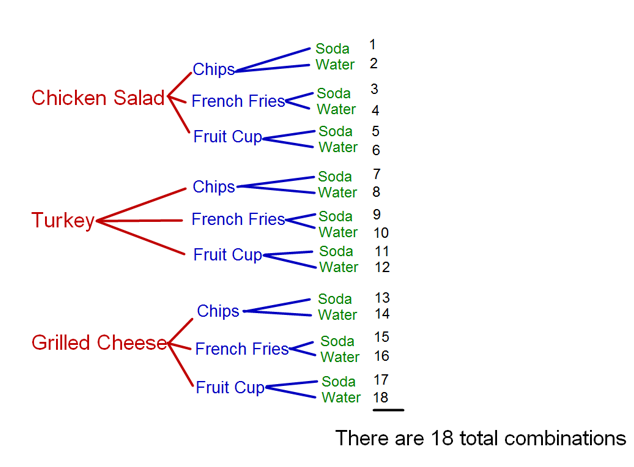Using the Fundamental Counting Principle to Determine the Sample Space
As we dive deeper into more complex probability problems, you may start wondering, "How can I figure out the total number of outcomes, also known as the sample space?"
We will use a formula known as the fundamental counting principle to easily determine the total outcomes for a given problem.
First we are going to take a look at how the fundamental counting principle was derived, by drawing a tree diagram.
Example 1 - Tree Diagram
A new restaurant has opened and they offer lunch combos for $5.00. With the combo meal you get 1 sandwich, 1 side and 1 drink. The choices are below.
Sandwiches: Chicken Salad, Turkey, Grilled Cheese
Sides: Chips, French Fries, Fruit Cup
Drinks: Soda, Water
Draw a tree diagram to find the total number of possible outcomes.

We were able to determine the total number of possible outcomes (18) by drawing a tree diagram. However, this technique can be very time consuming.
The fundamental counting principle will allow us to take the same information and find the total outcomes using a simple calculation. Take a look.
Example 1 -Using the Fundamental Counting Principle
Fundamental Counting Principle
If you have a ways of doing event 1, b ways of doing event 2, and c ways of event 3, then you can find the total number of outcomes by multiplying:
a x b x c
This principle is difficult to explain in words. To find the total number of outcomes for the scenario, multiply the total outcomes for each individual event.
For Example 1:
3 choices of sandwiches • 3 choices of sides • 2 choices of drinks
3 • 3 • 2 = 18 total outcomes
As you can see, this is a much faster and more efficient way of determining the total outcomes for a situation.
Let's take a look at another example.
Example 2
The Bagel Factory offers 12 different kinds of bagels and 4 types of cream cheese. How many possible combinations of bagels and cream cheese are there?
Solution:
12 kinds of bagels • 4 types of cream cheese = total outcomes
12 • 4 = 48
There are 48 different combinations of bagels and cream cheese.
I would not want to draw a tree diagram for Example 2! However, we were able to determine the total outcomes by using the fundamental counting principle.
Let's look at one more example and see how probability comes into play.
Example 3
A pair of dice is rolled once. How many possible outcomes are there? What is the probability of rolling doubles?
Solution:
- Use the fundamental counting principle to find the total outcomes:
6 sides on die 1 • 6 sides on die 2 = total outcomes
6 • 6 = 36
There are 36 total outcomes.
- Finding the probability of rolling doubles:
There are 6 sets of doubles (1,1: 2,2: 3,3: 4,4: 5,5: 6,6)
6 = 1 6 chances of rolling doubles
36 6 36 total outcomes
The probability of rolling doubles is 1/6, or .167 or 16.7% chance.
Although you may think that drawing the tree diagrams is fun, it's much
easier to use the formula, isn't it? I hope you had fun - now it's time
to move on to probability of independent events.

Need More Help With Your Algebra Studies?
Get access to hundreds of video examples and practice problems with your subscription!
Click here for more information on our affordable subscription options.
Not ready to subscribe? Register for our FREE Pre-Algebra Refresher course.





Comments
We would love to hear what you have to say about this page!